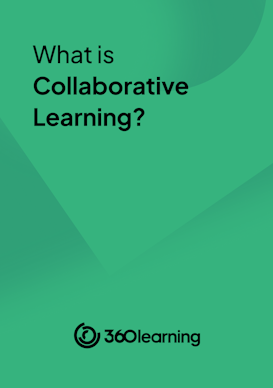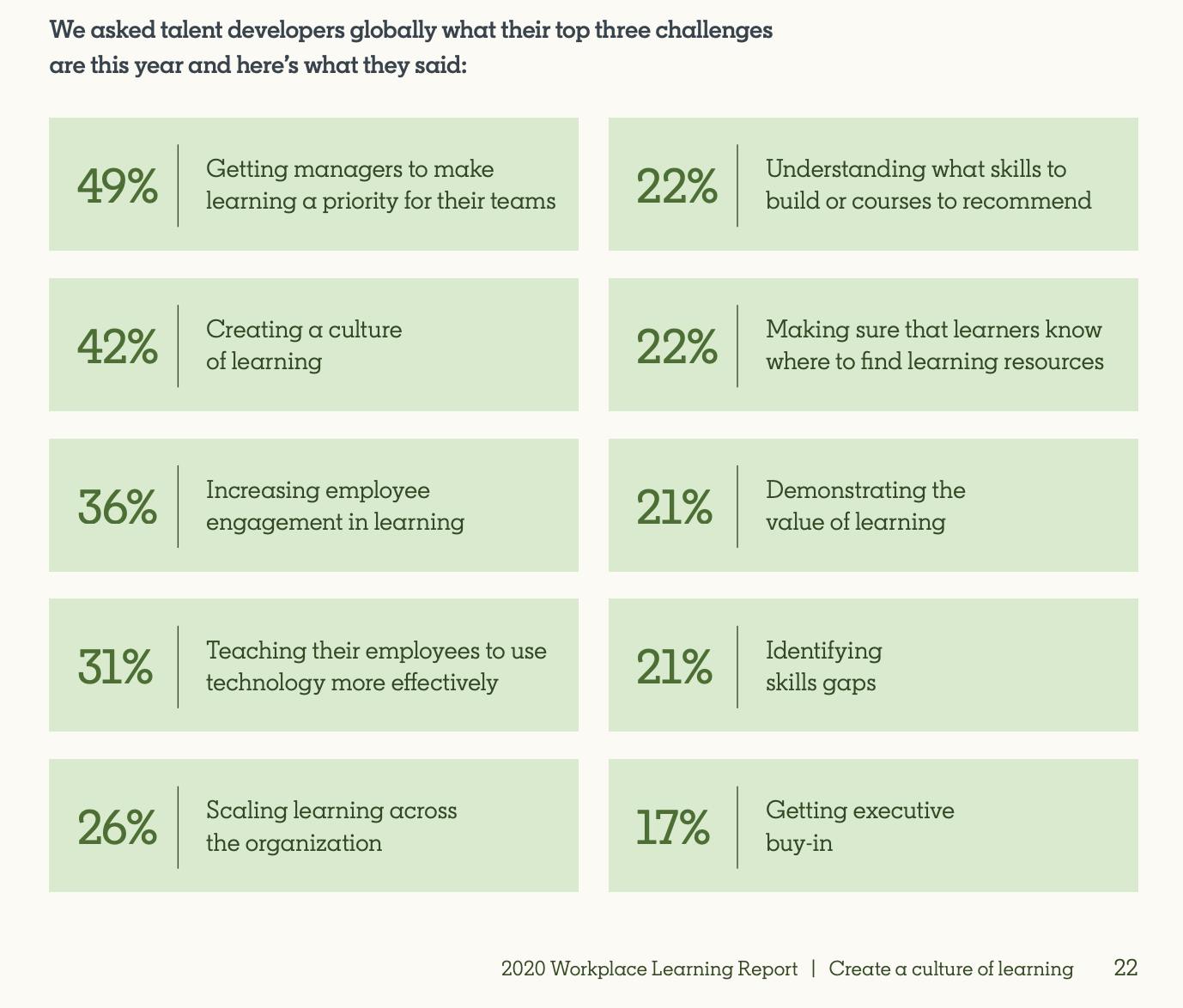Book your 360Learning demo now
A 30-minute overview of the platform
100% tailored to your needs - with ❤️
No commitment. Free as can be.
On average, it takes 130 hours and $22,178 to create a single hour of eLearning. All that for employees who usually think they have better things to do. The worst part? In the back of your mind, you know that hour of learning will be outdated by the end of the year.
Traditional employee training programs are slow, expensive, and value compliance over learning outcomes. When companies default to this model, L&D departments feel like they’re on a hamster wheel, sprinting but getting nowhere.
They’re constantly trying to understand their employees’ various and shifting needs, but trip up over clunky processes to secure technical knowledge and executive buy-in. And while L&D teams are scrambling to keep up, trainees are snoring through outdated and irrelevant training content.
Fortunately, there’s a better approach: peer training. By turning the traditional top-down model on its head, peer training saves time and money while boosting learning outcomes from L&D initiatives.
Before we break down why peer training is such a better investment, let’s take a look at what it means.
It takes 130 hours and $22,178 to create a single hour of eLearning. All that for employees who usually think they have better things to do.
Peer training (also called peer-to-peer training) is a training approach that puts Collaborative Learning at the forefront.
Instead of grafting the traditional student-teacher classroom relationship—which we call “top-down” learning—onto the workplace, peer training operates from the bottom up. This means every team member, no matter their position, can shape learning content by building courses from their skill sets, by asking and answering questions, and by providing additional information to flesh out existing content.
Peer training programs work well because they establish an ongoing dialogue between learners and in-house experts. In real-time, employees can ask questions about existing learning content (or request new content altogether). Then, in-house experts can respond to that specific learner’s need on a lasting, public forum, or create a new training course for the topic.
This back and forth results in richer, more precise learning content than traditional methods, which rely on one-way, best-guess flows of information.
Now that we have a working definition of peer training, let’s crack open three reasons your L&D team should make the switch.

By providing your contact info, you agree to receive communications from 360Learning. You can opt-out at any time. For details, refer to our Privacy Policy.
Peer training is faster and more affordable than a traditional top-down approach because it eliminates the L&D bottleneck.
Under a top-down approach, all learning content creation is centralized in L&D: They conduct needs assessments, create new modules, and roll out training updates. One solution is to expand the L&D department or hire an external instructional designer to increase bandwidth and produce training at a faster rate, but that costs tens of thousands annually, at least.
Peer training, on the other hand, bypasses the L&D bottleneck and high costs by allowing employees to shape training content directly. With the right learning software, a manager can create a new online course for their team in a matter of minutes—not weeks or months. Also, rather than waiting for an annual training assessment and refresh, team members can update and iterate courses in real time by asking questions, suggesting best practices, and providing feedback about courses.
This speed is especially important for large or distributed companies in need of scalable training solutions. 26% of L&D professionals rank the scalability of learning programs as one of their top three concerns in 2020, a number that has likely only risen since the explosion of remote work in response to the COVID-19 pandemic.

As the modern workplace shifts to accommodate growth and new normals, it’s unreasonable to expect top-down training design and deployment to keep up, especially without repeatedly dumping tens of thousands of dollars into new courses.
Conversely, peer training actually benefits from scale: More users means more perspectives, more inputs, and, in the end, a more comprehensive learning tool designed that improves overall employee competency.
Related: Centralized vs. Decentralized - Which is the Right L&D Approach for Your Business?
Peer training generates highly relevant and engaging learning content because the material is crowdsourced from those closest to the action: subject-matter experts, authorities on company culture, and new hires with training on the top of their mind.
In one-way learning models, L&D professionals are responsible for building training that addresses their employees’ needs, but often lack the subject-matter expertise necessary to develop functional and comprehensive courses. To get around this, they might hire external consultants or work with an in-house expert during course creation. Under the top-down model, however, they still struggle to get the right information to the right employee at the right time: A survey of over 1,000 US workers revealed that 60% of employees find it difficult to obtain the knowledge they require to do their job and waste an average of 5.3 hours working around top-down training in an attempt to find it.
Faced with inadequate training, employees already turn to one another to get up to speed. Most corporate learning happens through on-the-job social learning with colleagues and managers. This type of social learning is a good thing, considering 42% of valuable institutional knowledge is unique to the individual employee. In other words, nearly half of the knowledge it takes to do any given employee’s job exists inside of information silos rather than being company standard and represented in training materials.
Recently, we published a blog post describing why not sharing institutional knowledge is costing your company. Consider turnover, for example. If institutional knowledge isn’t shared and recorded, employees take a huge chunk of valuable wisdom with them when they leave the company. While improving employee retention helps solve this, L&D professionals should also be encouraging their teams to share what they know about how to do their job in order to make sure every team member has access to that knowledge.
Peer training aims to do just that: knock down information silos by facilitating the exchange of institutional knowledge. It empowers expert, in-the-field employees to create and refine course content to ensure it’s comprehensive, highly relevant, and genuinely helpful.
At 360Learning, our engagement data paint a picture of just how well employees respond to this approach. Courses created on 360Learning’s platform are consistently completed at a rate of about 90% within the first 24 hours. Plus, learners aren’t just passively ticking the training box: About 60% of those courses include some sort of assignment. We also typically see that about 20–30% of employees perform additional interactions, such as asking questions or amending training with further recommendations and best practices.
According to LinkedIn’s 2020 Workplace Learning Report, 35% of L&D pros cited increasing employee engagement as a top priority for 2020. We firmly believe peer training is part of the solution. Our standout engagement metrics speak to peer training’s ability to provide employees with the knowledge they need when they need it, and the power of tools that help teams teach and learn from one another. The takeaway? Don’t sleep on peer training.
Currently, 45% of L&D professionals spend nearly half their working hours building and developing courses—peer training gives you some of that time back.
Under the top-down model, L&D pros are flooded with training requests and struggle to keep up because they’re often working with limited knowledge of the subject matter. Not only is this constant scramble exhausting, but spending so much on course content creation means L&D pros don’t have adequate time to deploy, promote, and optimize those courses. For example, only 16% of L&D hours go toward promoting training programs, even though driving learning engagement stands as the top priority among L&D professionals.
With peer learning, on the other hand, L&D departments can shift their efforts away from content creation and into projects with larger-scale benefits. First, L&D departments play a key role in choosing the right learning technology and establishing a culture of learning to get peer learning up and running in their organization. Once they secure buy-in from their team, however, they can shift their efforts to facilitating and coaching, conducting skills gap analyses to help the company identify and eliminate knowledge gaps, and measuring training impact to prove ROI and justify spending.
Related: Don't be a Toby: Reinvent the Role of L&D with 360Learning for Enterprise
45% of L&D professionals spend nearly half their working hours building and developing courses—peer training gives you some of that time back.
Peer training is a pretty radical departure from traditional learning on a conceptual level, but it requires real-life tools to execute. And as the world continues to adapt to remote work and online learning, it’s even more important to provide a solid infrastructure so your employees can quickly access the high-quality resources and knowledge they need to do their jobs. That’s where 360Learning comes in.
360Learning is the industry’s first Collaborative Learning platform. Its intuitive tools allow users—even if they’re not learning professionals—to author interactive courses in a matter of minutes, eliminating barriers to knowledge sharing and elevating the employee’s role in their own training. Interested in learning more? Book a free demo today.
A 30-minute overview of the platform
100% tailored to your needs - with ❤️
No commitment. Free as can be.
By providing your contact info, you agree to receive communications from 360Learning. You can opt-out at any time. For details, refer to our Privacy Policy.